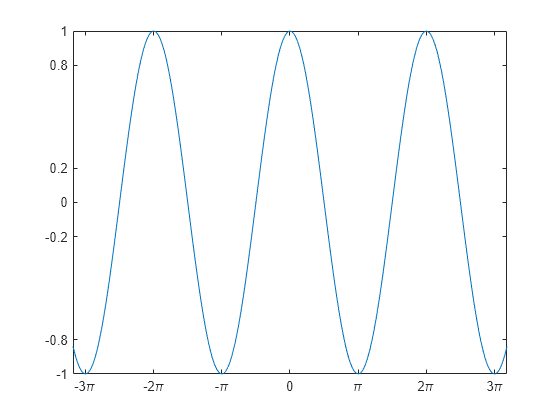Definizione dei valori e delle etichette delle tacche sugli assi
La personalizzazione dei valori e delle etichette delle tacche lungo un asse può aiutare a evidenziare aspetti particolari dei dati. Questi esempi mostrano alcune personalizzazioni comuni, come la modifica della posizione del valore delle tacche, la modifica del testo e della formattazione dell'etichetta delle tacche e la rotazione delle etichette delle tacche.
Modifica delle posizioni del valore delle tacche e delle etichette
Creare x come 200 valori spaziati linearmente tra -10 e 10. Creare y come coseno di x. Tracciare i dati.
x = linspace(-10,10,200); y = cos(x); plot(x,y)

Modificare le posizioni del valore della tacca lungo l'asse x e l'asse y. Specificare le posizioni come vettore di valori crescenti. Non è necessario che i valori siano equidistanti.
Inoltre, modificare le etichette associate a ciascun valore delle tacche lungo l'asse x. Specificare le etichette utilizzando un array di celle di vettori di caratteri. Per includere caratteri speciali o lettere greche nelle etichette, utilizzare il markup TeX, ad esempio \pi per il simbolo .
xticks([-3*pi -2*pi -pi 0 pi 2*pi 3*pi])
xticklabels({'-3\pi','-2\pi','-\pi','0','\pi','2\pi','3\pi'})
yticks([-1 -0.8 -0.2 0 0.2 0.8 1])
Per le release antecedenti alla R2016b, impostare i valori delle tacche e le etichette utilizzando invece le proprietà XTick, XTickLabel, YTick e YTickLabel dell'oggetto Axes. Ad esempio, assegnare l'oggetto Axes a una variabile, come ax = gca. Quindi, impostare la proprietà XTick utilizzando la notazione a punti, come ax.XTick = [-3*pi -2*pi -pi 0 pi 2*pi 3*pi]. Per le release antecedenti alla R2014b, utilizzare invece la funzione set per impostare la proprietà.
Rotazione delle etichette delle tacche
Creare un grafico a dispersione e ruotare le etichette delle tacche lungo ciascun asse. Specificare la rotazione come valore scalare. I valori positivi indicano la rotazione in senso antiorario. I valori negativi indicano la rotazione in senso orario.
x = 1000*rand(40,1); y = rand(40,1); scatter(x,y) xtickangle(45) ytickangle(90)

Per le release antecedenti alla R2016b, specificare la rotazione utilizzando invece le proprietà XTickLabelRotation e YTickLabelRotation dell'oggetto Axes. Ad esempio, assegnare l'oggetto Axes a una variabile, come ax = gca. Quindi, impostare la proprietà XTickLabelRotation utilizzando la notazione a punti, come ax.XTickLabelRotation = 45.
Modifica della formattazione dell'etichetta della tacca
Creare un grafico a stelo e visualizzare i valori delle etichette delle tacche lungo l'asse y come valori espressi in dollari USA.
profit = [20 40 50 40 50 60 70 60 70 60 60 70 80 90];
stem(profit)
xlim([0 15])
ytickformat('usd')
Per un maggiore controllo sulla formattazione, specificare un formato personalizzato. Ad esempio, mostrare un valore decimale nelle etichette delle tacche dell'asse x utilizzando '%.1f'. Visualizzare le etichette delle tacche lungo l'asse y come sterline inglesi utilizzando '\xA3%.2f'. L'opzione \xA3 indica il carattere Unicode per il simbolo della sterlina. Per maggiori informazioni su come specificare un formato personalizzato, vedere la funzione xtickformat.
xtickformat('%.1f') ytickformat('\xA3%.2f')

Oggetti di regole per il controllo di singoli assi
MATLAB crea un oggetto di regole per ciascun asse. Come tutti gli oggetti dei grafici, anche gli oggetti di regole presentano proprietà che possono essere visualizzate e modificate. Gli oggetti di regole consentono un controllo maggiormente personalizzato sulla formattazione dell'asse x, dell'asse y o dell'asse z. Accedere all'oggetto di regole associato a un particolare asse tramite la proprietà XAxis, YAxis o ZAxis dell'oggetto Axes. Il tipo di regola dipende dal tipo di dati lungo l'asse. Per i dati numerici, MATLAB crea un oggetto NumericRuler.
ax = gca; ax.XAxis
ans =
NumericRuler with properties:
Limits: [0 15]
Scale: 'linear'
Exponent: 0
TickValues: [0 5 10 15]
TickLabelFormat: '%.1f'
Show all properties
Controllo del valore dell'esponente nell'etichetta secondaria utilizzando gli oggetti di regole
Tracciare i dati con valori y compresi tra -15.000 e 15.000. Per impostazione predefinita, le etichette delle tacche dell'asse y utilizzano la notazione esponenziale con un valore dell'esponente pari a 4 e una base pari a 10. Modificare il valore dell'esponente in 2. Impostare la proprietà Exponent dell'oggetto di regole associato all'asse y. Accedere all'oggetto di regole tramite la proprietà YAxis dell'oggetto Axes. L'etichetta secondaria e le etichette delle tacche cambiano conseguentemente.
x = linspace(0,5,1000); y = 100*exp(x).*sin(20*x); plot(x,y) ax = gca; ax.YAxis.Exponent = 2;

Modificare il valore dell'esponente in 0 in modo che le etichette delle tacche non utilizzino la notazione esponenziale.
ax.YAxis.Exponent = 0;

Vedi anche
Funzioni
xlim|xticks|yticks|zticks|xtickformat|xtickangle|xsecondarylabel|ysecondarylabel